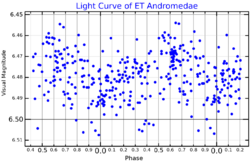Astronomy:ET Andromedae
| Observation data Equinox J2000.0]] (ICRS) | |
|---|---|
| Constellation | Andromeda |
| Right ascension | 23h 17m 56.011185s[2] |
| Declination | +45° 29′ 20.1197″[2] |
| Apparent magnitude (V) | 6.48[3] |
| Characteristics | |
| Spectral type | A0 Vp SiSr[4] or B9p SI[5] |
| B−V color index | −0.037±0.006[3] |
| Variable type | α2 CVn |
| Astrometry | |
| Radial velocity (Rv) | −0.30±4.10[3] km/s |
| Proper motion (μ) | RA: +24.740[2] mas/yr Dec.: −11.038[2] mas/yr |
| Parallax (π) | 5.4200 ± 0.0572[2] mas |
| Distance | 602 ± 6 ly (185 ± 2 pc) |
| Absolute magnitude (MV) | 0.58[6] |
| Orbit[7] | |
| Period (P) | 48.304±0.007 d |
| Eccentricity (e) | 0.50±0.05 |
| Periastron epoch (T) | 2443720.11±0.64 JD |
| Argument of periastron (ω) (secondary) | 49.8±6.0° |
| Semi-amplitude (K1) (primary) | 25.7±2.0 km/s |
| Details | |
| Mass | 3.25[8] M☉ |
| Radius | 2.7[9] R☉ |
| Luminosity | 91.06[3] L☉ |
| Surface gravity (log g) | 3.81[10] cgs |
| Temperature | 11,444[10] K |
| Rotation | 1.62 d[11] |
| Rotational velocity (v sin i) | 65[12] km/s |
| Age | 284[6] Myr |
| Other designations | |
| Database references | |
| SIMBAD | data |
ET Andromedae is a binary star system star in the northern constellation of Andromeda.[14] It has an apparent visual magnitude of 6.48,[3] placing it at the nominal limit for visibility with the naked eye. The distance to this system can be estimated from its annual parallax shift of 5.42 mas,[2] which yields a value of 602 light years.
Variations in the radial velocity of this star suggest it is a single-lined spectroscopic binary system. This yields orbital elements with a period of 48.3 days and an eccentricity of 0.50. The a sin i value for the primary is 14.8 Gm (0.099 astronomical unit|AU), where a is the semimajor axis and i is the (unknown) orbital inclination.[7]
The visible component is a well-studied magnetic chemically peculiar star[15] with a stellar classification of A0 Vp SiSr.[4] The SiSr notation indicates unusual abundances of silicon and strontium in the spectrum. It has a magnetic field with an average surface value of 3.2 kT.[16] The abundance of silicon varies depending on the viewing angle.[15] The star is an Alpha2 Canum Venaticorum variable with a period of 1.618875 days.[17]
References
- ↑ Blanco, C.; Catalano, F. A.; Strazzulla, G. (January 1980). "The light variations of the Ap Star HR 8861". Astronomy & Astrophysics Supplement Series 39: 127–128. http://articles.adsabs.harvard.edu/pdf/1980A%26AS...39..127B. Retrieved 8 October 2021.
- ↑ 2.0 2.1 2.2 2.3 2.4 2.5 Brown, A. G. A. (August 2018). "Gaia Data Release 2: Summary of the contents and survey properties". Astronomy & Astrophysics 616: A1. doi:10.1051/0004-6361/201833051. Bibcode: 2018A&A...616A...1G.
- ↑ 3.0 3.1 3.2 3.3 3.4 Anderson, E.; Francis, Ch. (2012), "XHIP: An extended hipparcos compilation", Astronomy Letters 38 (5): 331, doi:10.1134/S1063773712050015, Bibcode: 2012AstL...38..331A.
- ↑ 4.0 4.1 Abt, Helmut A.; Morrell, Nidia I. (1995). "The Relation between Rotational Velocities and Spectral Peculiarities among A-Type Stars". Astrophysical Journal Supplement 99: 135. doi:10.1086/192182. Bibcode: 1995ApJS...99..135A.
- ↑ Cowley, A. et al. (April 1969). "A study of the bright A stars. I. A catalogue of spectral classifications". Astronomical Journal 74: 375–406. doi:10.1086/110819. Bibcode: 1969AJ.....74..375C.
- ↑ 6.0 6.1 Gontcharov, G. A. (November 2012). "Spatial distribution and kinematics of OB stars". Astronomy Letters 38 (11): 694–706. doi:10.1134/S1063773712110035. Bibcode: 2012AstL...38..694G.
- ↑ 7.0 7.1 Ouhrabka, M.; Grygar, J. (May 1979). "Spectroscopic evidence for the binary nature of the Ap star". Information Bulletin on Variable Stars 1600: 1. Bibcode: 1979IBVS.1600....1O.
- ↑ Ducati, J. R. et al. (2011). "The mass ratio and initial mass functions in spectroscopic binaries". Astronomy and Astrophysics 525: A26. doi:10.1051/0004-6361/200913895. Bibcode: 2011A&A...525A..26D. http://www.lume.ufrgs.br/bitstream/10183/99264/1/000821103.pdf.
- ↑ Pasinetti Fracassini, L. E. et al. (2001). "Catalogue of Apparent Diameters and Absolute Radii of Stars (CADARS)". Astronomy & Astrophysics 367 (2): 521–24. doi:10.1051/0004-6361:20000451. Bibcode: 2001A&A...367..521P.
- ↑ 10.0 10.1 Adelman, Saul J. (2002). "On the Periods of the Magnetic CP Stars". Baltic Astronomy 11: 475–485. Bibcode: 2002BaltA..11..475A.
- ↑ Kreidl, T. J. (October 1993), "A Null Detection of Rapid Oscillations in the Ap Star ET And", Information Bulletin on Variable Stars 3945: 1, Bibcode: 1993IBVS.3945....1K
- ↑ Strom, Stephen E. et al. (2005). "B Star Rotational Velocities in h and χ Persei: A Probe of Initial Conditions during the Star Formation Epoch?". The Astronomical Journal 129 (2): 809–828. doi:10.1086/426748. Bibcode: 2005AJ....129..809S.
- ↑ "HD 13530". SIMBAD. Centre de données astronomiques de Strasbourg. http://simbad.u-strasbg.fr/simbad/sim-basic?Ident=HD+13530.
- ↑ Watson, Christopher (4 February 2010). "ET Andromedae". AAVSO Website. American Association of Variable Star Observers. http://www.aavso.org/vsx/index.php?view=detail.top&oid=163.
- ↑ 15.0 15.1 Adelman, Saul J. (May 2000). "UVBY photometry of the magnetic CP stars HD 36668, 36 Lyncis, HD 86592, and HR 8861". Astronomy and Astrophysics 357: 548–552. Bibcode: 2000A&A...357..548A.
- ↑ Glagolevskij, Yu. V. (September 2007). "Magnetic-field dependence of chemical anomalies in CP stars". Astrophysical Bulletin 62 (3): 244–256. doi:10.1134/S1990341307030054. Bibcode: 2007AstBu..62..244G.
- ↑ Samus', N. N.; Kazarovets, E. V.; Durlevich, O. V.; Kireeva, N. N.; Pastukhova, E. N. (2017), "General catalogue of variable stars: Version GCVS 5.1", Astronomy Reports 61 (1): 80–88, doi:10.1134/S1063772917010085, Bibcode: 2017ARep...61...80S.
 |


